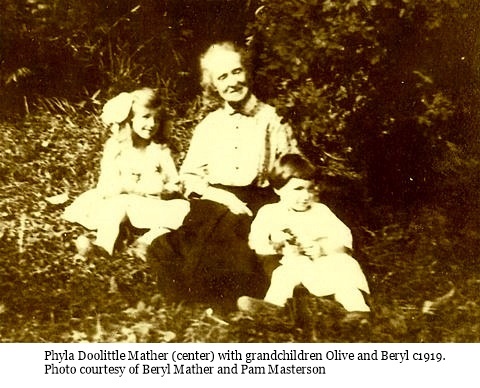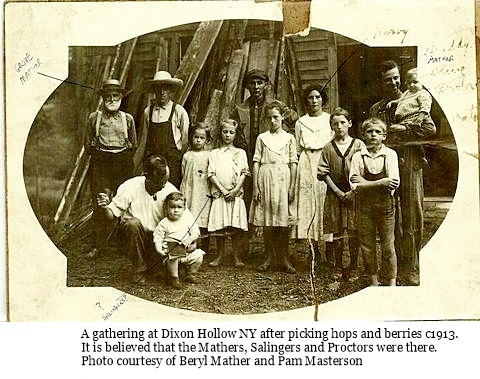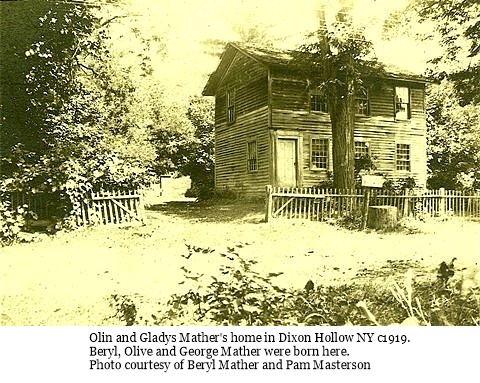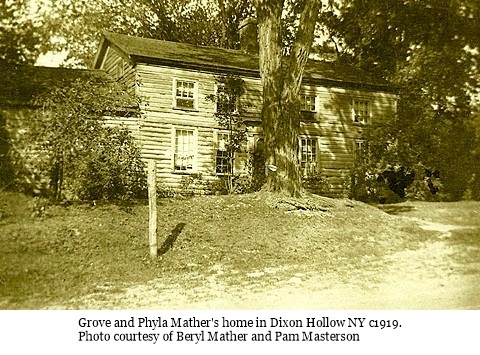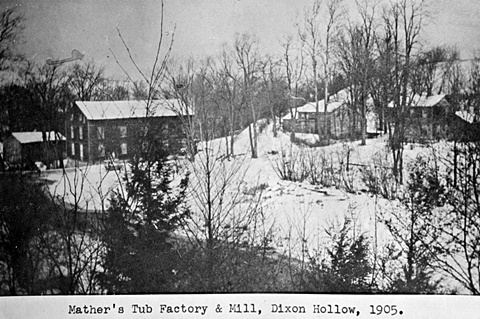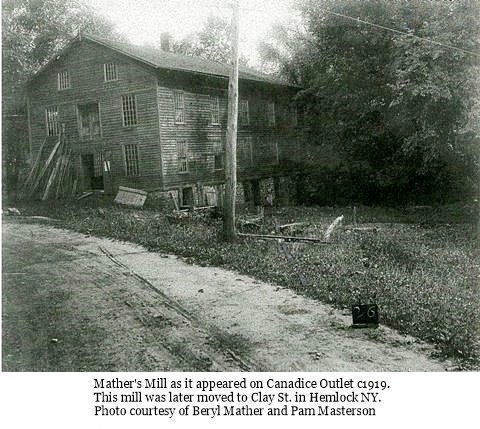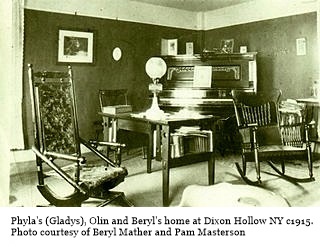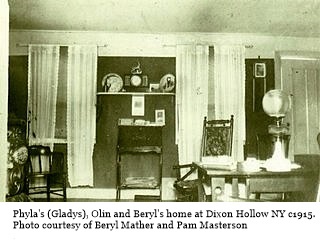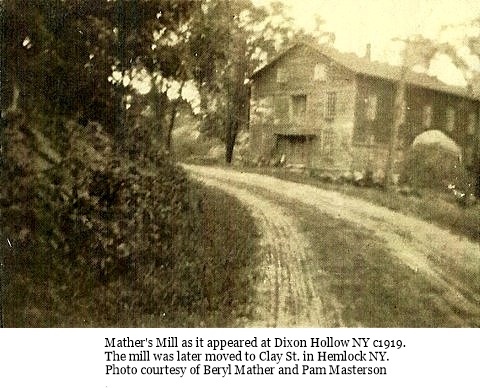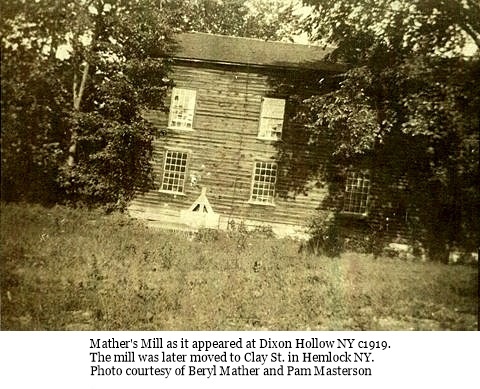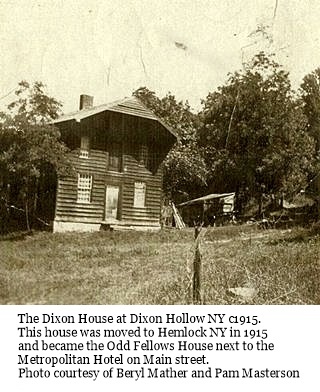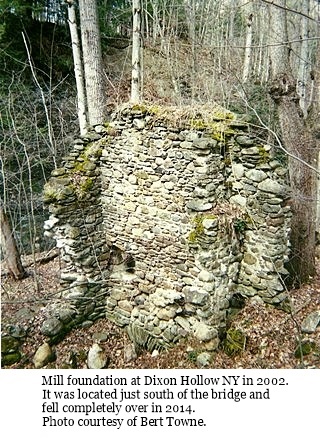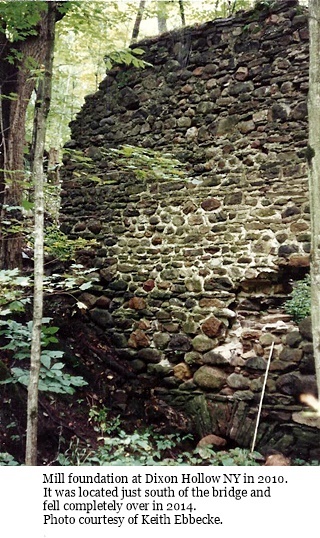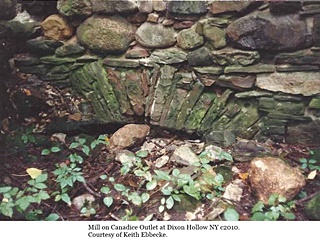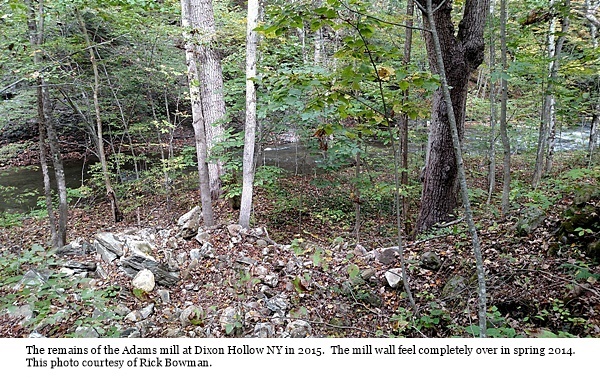
Welcome to Hemlock and Canadice Lakes!
Barns Businesses Cemeteries Churches Clinton & Sullivan Columns Communities Documents Events Time Line Fairs & Festivals Farm & Garden Hiking Homesteads Lake Cottages Lake Scenes Landscapes Library News Articles Old Maps Old Roads & Bridges Organizations People Photo Gallery Podcasts Railroad Reservoir Schools State Forest Veterans Videos
|
History of Dixon Hollow NY |
Click any image to enlarge. |
|
Dixon Hollow was a small milling community located along the Canadice Outlet between Hemlock and Canadice Lakes prior to 1920. The Dixon Hollow Road passed through Dixon Hollow and provided access to Canadice Road in the east and North Old Bald Hill in the west. The community was removed as the City of Rochester developed the reservoir. Eventually the road was closed to road traffic but not without concern. |
|
1 Phyla Doolittle Mather with grandchildren Olive and Beryl circa 1919. Courtesy of Beryl Mather and Pam Masterson. |
|
2 A gathering at Dixon Hollow after picking hops or berries circa 1913. It is believed that the Mather’s, Salinger’s and Proctor’s were there. Courtesy of Beryl Mather and Pam Masterson. |
|
3 Olin and Gladys Mather’s home in Dixon Hollow, Canadice NY circa 1919. The house was across the road from the mill. Beryl, Olive and George Mather were born here. The well was found on the property in 2002. Courtesy of Beryl Mather and Pam Masterson. |
|
4 The Mather’s Homestead as it appeared on Canadice Outlet between Hemlock and Canadice Lakes circa 1919. The mill was later moved to Clay Street in Hemlock village where it became a cider mill and eventually apartments. Courtesy of Beryl Mather and Pam Masterson. |
|
5 A more distant view of the Mather’s Homestead on the Canadice outlet in 1905. Courtesy of Beryl Mather and Pam Masterson. |
|
6 Mather’s mill as it appeared on Canadice Outlet between Hemlock and Canadice Lakes circa 1919. The mill was later moved to Clay Street in Hemlock village where it became a cider mill and eventually apartments. Courtesy of Beryl Mather and Pam Masterson. |
|
7 8 Inside Phyla’s (Glady’s), Olin & Beryl Mather’s home in Dixon Hollow, Canadice NY circa 1915. Courtesy of Beryl Mather and Pam Masterson. |
|
9 Mather’s mill as it appeared on Canadice Outlet between Hemlock and Canadice Lakes circa 1919. The mill was later moved to Clay Street in Hemlock village where it became a cider mill and eventually apartments. Courtesy of Beryl Mather and Pam Masterson. |
|
10 Another view of the Mather’s mill circa 1919. This mill was moved to Clay Street in Hemlock when the City of Rochester began removing buildings for the reservoir. Courtesy of Beryl Mather and Pam Masterson. |
|
From the Livonia Gazette circa 1930.
Canadice Outlet Thrived By Frank Connor Hemlock - Dixon’s Hollow was a small village, named after Ezra Dixon. It contained a grocery story, saw-mill, blacksmith shop, grist mill, and carding and spinning mill. Down Canadice Outlet was another small village called Presbys, composed of a few houses, sawmill and carding mill. These mills, all operated by water power, originally overshot water wheels, later converted to pit wheels. The masonry of the old grist mill is still standing, showing the pit and raceway. A Mr. Dixon, I understand, erected and operated both mills at one time. Later he sold the grist mill to a man named Fox, who sold to Willis Adams, who was running the grocery store. Wooden Bathtubs The sawmill was purchased by Grove Mather, who made butter tubs, pails and bathtubs. A man here in Hemlock has one of the bathtubs. Later Mather put in a clapboard saw and other wood-working machines. His main business was butter tubs. These he sold locally, and if I remember correctly, Smith, Perkins Co. was his main customer in Rochester. Mr. Mather sawed out the clapboards for my house in 1915. In 1914 I purchased on the stump 21 basswood trees around 3 feet at the butt. They cost $19, the saw bill was $22, and they yielded 44,000 feet of good lumber. Each tree had three large logs 18 feet long, and I don’t recall the number of small logs. My brother and I each built our houses of this basswood; mine 28 x 28 feet, his some larger. Back to the Hollow Willis Adams purchased the mill and store at Gullburgh and sold out to D. S. Beam. Rochester City, when it took over Canadice Lake, purchased the Mather property and all along the outlet. Olin Mather, who sold it out, moved the old mill to Hemlock Village and re-erected it for a cider mill and dry house. It has now passed into the hands of William Fletcher, who is considering rebuilding it into apartments. Durable Paint Down the outlet, below Dixon’s Hollow, was another village, Gullburgh, which Beam changed to Glenville. This village, besides having the store and grist mill, had a paint factory which manufactured indelible paint. It was red paint, made from burning the shale rock abounding there, and was durable, as some of the old buildings still show traces of it. This mill was operated by Hart & Thurston and was operating as late as 1872. Canadice outlet, wherever it made a bend, had what was called a sheep hole, where farmers washed their sheep before shearing them. The Mather mill stood where the broken concrete remains. It was the dam erected shortly before he sold out to the City. Originally it was a log dam, which rotted out. All traces of the grist mill have disappeared, as it was torn down about 50 years ago. A short distance below the grist mill, a large iron bridge spanned the outlet. This was taken down about 20 years ago.
|
|
From the Democrat & Chronicle November 1940.
Hemlock Residents Oppose Ban Dixon Hollow Road to be Closed By Amo T. Kreiger Hemlock - Attention to the Village of Hemlock is focused on the probable fate of the Dixon Hollow Road, a mile stretch of crossroad in the Hemlock - Canadice locality, 2 1/2 miles southeast of Hemlock, pending outcome of a recent ruling by the Livingston County Board of Supervisors ordering the road’s bridge closed to traffic. Threatened closing of the old bridge, which would mean ultimate closing of the scenic Dixon Hollow Road connecting Canadice - Hollow and the Old Bald Hill Road, in olden times a main artery of travel, has met with a storm of protest from Hemlock residents who view with keen regret the possible passing of the old route through an area rich in historic associations and the site of a former industrial center. Leaders representing the Hemlock Civic Association made an urgent appeal to the supervisors’ board to reconsider the recent action barring the bridge from use. They were supported by a petition containing the names of virtually all taxpayers in School District 4. The state, they point out, has urged that roads leading through historic New York State be maintained, emphasis being placed upon scenic routes. Investigation has been made by a committee appointed by the board and Hemlock residents are awaiting a decision. Once a Thriving Site Before the wave of industrial tides, highest in obscure rural areas in the middle of the last century, had receded leaving many Western New York hamlets destined to a gradual decay, the settlement at Dixon Hollow was a thriving manufacturing site. The little hamlet, shorn of its former glamour, a ghost village now haunted by memories of a prosperity long vanished, once had 50 buildings and rang to the din of mills and the swift rush of water over busily turning water wheels. It was a place of bustling activity in its heyday. A flour mill, woolen mill, tannery, cooperage shop and distilleries employed a large force of workmen. At a sawmill a vertical saw converted virgin timber into lumber for the sturdy farm dwellings that still dot the countryside. Spokes and hubs of wagon wheels which were sold to blacksmiths were manufactured in a shop here. At the grist mill a daily grind of five barrels was considered a good days work at that period. A 200 foot drop in the creek bed of Canadice Outlet that maintained a steady flow of water powered the mills. In the early days distilleries here turned surplus grain into whiskey for easier shipment to eastern markets. Locally the output sold for two shillings a gallon and three cents a glass at a tavern operated in that section. Had a Blacksmith Shop A blacksmith shop perched precariously on the narrow strip of land between the road and the steep bank of the gorge adjacent to the bridge. “You didn’t have to throw an object out the window with any force to have it land in the creek below. You could drop it out and the water would carry it away,” Olin Mather, Hemlock businessman who was born in Dixon Hollow, recalled. At night when the day’s work was over at the mills and the farms, men sought the peace of its interior made cheerful in the darkness by the red glow of the embers on the forge where the talk of the village was exchanged. The busy hum of the mills was accented frequently by the rumble of heavy wagons loaded with produce for shipment on mule-drawn barges on the Erie Canal. Teams and drivers were changed at the village of Lima for the remainder of the trip to Pittsford. There would be a steady stream of vehicular traffic, Mather said. Top buggies and democrat wagons of farmers from the surrounding hill-enclosed countryside rattled over the bridge on the short-cut to Hemlock, a base of supplies and a mail distributing point. |
|
11 The Dixon House, Dixon Hollow Canadice NY circa 1915. The house was moved in 1915 to Hemlock village and became the Odd Fellows House next to the Metropolitan Hotel. Courtesy of Beryl Mather and Pam Masterson. |
12 The Adams mill foundation on Canadice Outlet in Dixon Hollow NY as it appeared in 2002. These remains fell completely over in the spring of 2014. Courtesy of Bert Towne. |
|
13 The Adams mill foundation on Canadice Outlet in Dixon Hollow NY as it appeared in c2010. These remains fell completely over in the spring of 2014. Courtesy of Keith Ebbecke. |
14 The Adams mill foundation on Canadice Outlet in Dixon Hollow NY as it appeared in c2010. These remains fell completely over in the spring of 2014. Courtesy of Keith Ebbecke. |
|
15 The remains of the Adams mill at Dixon Hollow NY in 2015. The mill wall feel completely over in spring 2014. This photo courtesy of Rick Bowman. |
